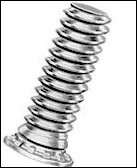| |
|
|
 |
Installation |
|
|
- Punch/drill a hole of given dimensions in the sheet
- Place the stud in the hole of the component and in the anvil as shown
in the animation, such that all the three are in line. [also note that,
the anvil surface, the sheet-metal, the head of the stud and the ram
of the punch are parallel.]
- Apply squeezing force on the head of the stud, so that the head needs
to be completely embedded in the sheet-metal and must finish flush with
the sheet-metal surface.
|
 |
Advantages |
|
|
- Easy installation
- Can be inserted in thin sheets[ 1.0mm and above]
- Avoids using loose hardware like bolts/screws
- Perfectly flush surface
- Can be used in various materials like, ms, ss, aluninium, plastics,
resins, frp, etc…
- Wide range of applications for PCBs...
- High torsional & push-out resistance due to clinching effect
provided by the designed serrations & grooves.
|
Sizes:
M2 to M10 in various lengths
Materials: Alloy Steel, Stainless Steel, and Aluminium
|
| |
